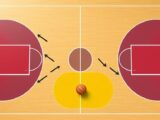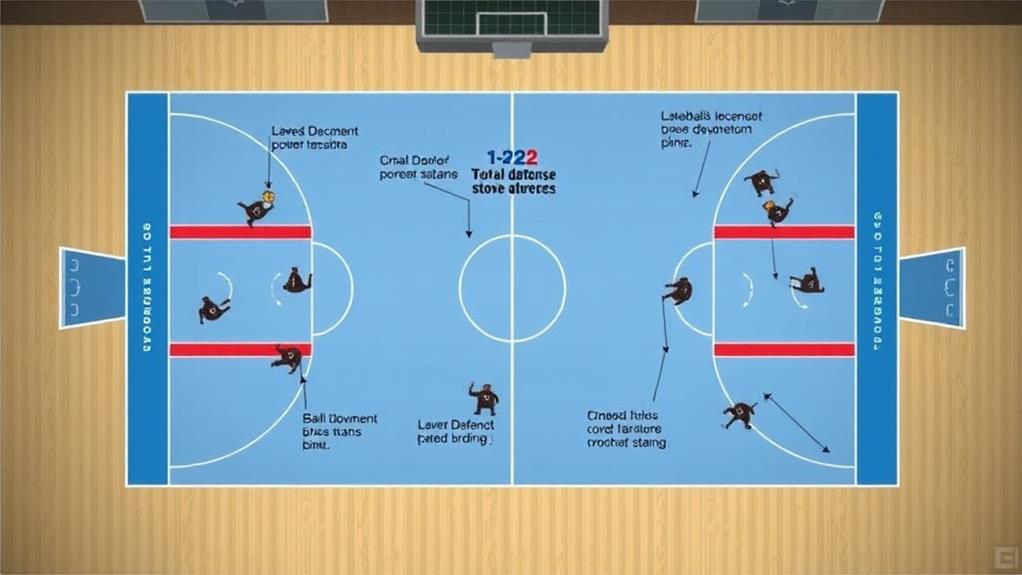
How to Set Up and Execute the 1-2-2 Zone Defense
September 19, 2024To set up and execute the 1-2-2 zone defense, position two players at the top and three in the middle and low post. The top players focus on outside shooters while the others guard the paint. Communicate effectively to guarantee quick rotations and deny high-percentage shots. Apply consistent ball pressure and be ready to trap when necessary. Remember, all players should actively pursue rebounds, as the zone can lead to vulnerabilities. To maximize your defense's effectiveness, adapt your strategies based on your opponent's strengths. Keep going, and you'll discover more tips on optimizing this defensive setup.
Overview of 1-2-2 Zone Defense
When you set up the 1-2-2 Zone Defense, you position your players strategically to maximize their effectiveness on the court. This setup features five players: two at the top applying pressure and three covering the middle and low post areas. The top players, typically Player 1 and Player 3, focus on preventing outside shots, while Player 4 and Player 5 protect the paint.
By utilizing data-driven strategies to analyze opponent tendencies, you can adjust your defensive scheme to better counter their offensive patterns. This defensive strategy excels against teams that rely heavily on perimeter shooting but struggle to score inside.
By using this Zone Defense, you create a solid barrier against outside attempts, forcing opponents to evaluate alternative options. Communication is key; your players must quickly adjust their positioning based on the ball movement and the locations of offensive players.
Incorporating elements of other strategies, like man-to-man or trapping techniques, can confuse opponents and disrupt their rhythm. For instance, when facing a ball screen, your top players should be ready to switch or hedge effectively, ensuring that no easy shots are available.
This adaptability is essential for maintaining the effectiveness of the 1-2-2 Defense throughout the game.
Strengths of the 1-2-2 Defense
The 1-2-2 zone defense offers several strengths that can greatly boost your team's performance. It effectively counters strong perimeter shooters by applying pressure and closing out quickly, while also creating quick transition opportunities after forcing turnovers.
By utilizing a strong defensive stance, players can maintain balance and react swiftly to offensive movements, enhancing the overall effectiveness of the defense. Enhanced defensive coordination allows your players to cover specific areas, limiting the offensive options for your opponents.
Employing techniques like approaching an attacker can further disrupt their plays.
Effective Against Shooters
Facing a team with strong outside shooters can be intimidating, but the 1-2-2 zone defense steps up to the challenge. This defensive setup excels at closing out on shooters quickly, making it hard for them to get clean looks from beyond the arc. Each player covers a specific area, enhancing your team's defensive coordination. This makes it tough for offensive players to find open shots, as they're constantly challenged.
By applying consistent ball pressure, the 1-2-2 zone forces offensive players to make quicker decisions. This can lead to rushed shots, increasing the chances of turnovers and missed opportunities. Your defense disrupts the opponents' offensive flow and rhythm, especially against teams that depend heavily on perimeter shooting.
When you contest shots effectively, you not only reduce the scoring chances but also shake the confidence of the shooters. They're used to shooting freely, but the 1-2-2 zone puts pressure on them, making them second-guess their attempts.
Quick Transition Opportunities
Utilizing the 1-2-2 zone defense not only stifles outside shooting but also sets the stage for quick scoring opportunities. When you apply ball pressure, you disrupt the opponent's rhythm, forcing them into rushed shots. This often leads to turnovers, which you can capitalize on for quick fast break plays.
With your players strategically positioned, they can swiftly convert from defense to offense. As soon as you secure a defensive rebound, your team should look to exploit the opponent's disorganization. Quick close-outs on shooters are essential; they not only contest shots but also create openings for fast breaks that can lead to easy baskets.
Efficient communication among your players is key during this phase. When everyone's aware of their roles, moving quickly becomes second nature, maximizing your scoring chances.
If you emphasize ball pressure and maintain your defensive intensity, you'll find that the 1-2-2 zone not only protects against shooting but also opens doors for rapid offensive opportunities. Embrace this strategy, and watch how it transforms your game.
Enhanced Defensive Coordination
In a well-executed 1-2-2 zone defense, players are assigned specific zones to cover, fostering a structured and organized approach to defensive play. This setup enhances defensive coordination by enabling each defensive player to focus on their designated area, allowing for quick rotations and effective help side defense when the ball is passed.
Strong communication among players is essential; it guarantees that everyone understands their responsibilities and can react promptly to offensive movements. The strategic positioning of players allows for rapid closing out on shooters, which contests shots while maintaining coverage in their respective zones.
The benefits of enhanced defensive coordination include:
- Improved area coverage that disrupts offensive flow
- Increased ability to force opponents into rushed shots
- Efficient rotations that minimize scoring opportunities
- Enhanced teamwork through clear communication
- Greater overall effectiveness against various offensive strategies
Weaknesses of the 1-2-2 Defense
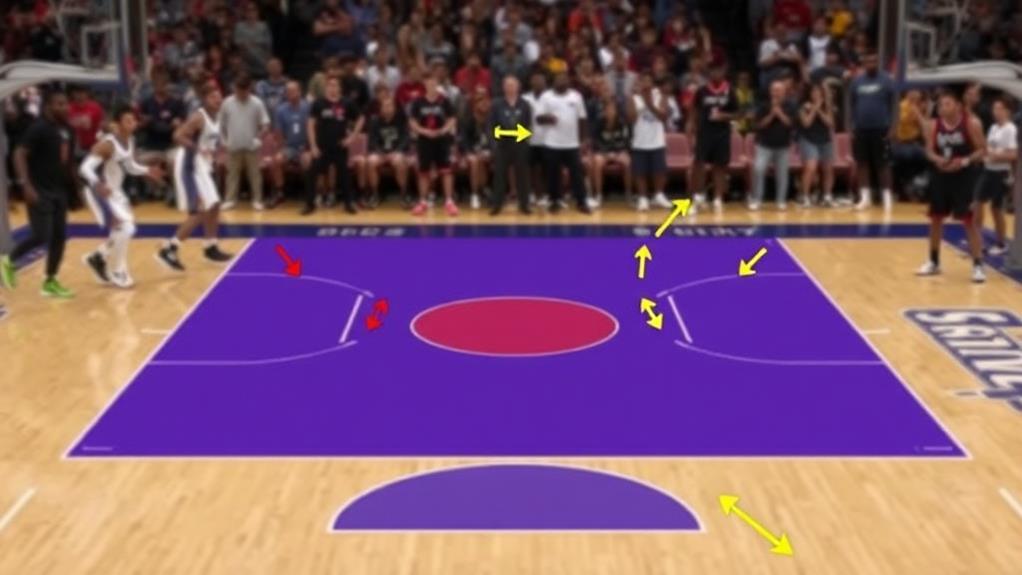
While the 1-2-2 zone defense has its advantages, it also has some significant weaknesses you need to be aware of.
It's particularly vulnerable to high post passes, which can lead to easy scoring opportunities for your opponents.
This layout can also struggle against skilled players who excel in small-sided games, as they can exploit gaps in the defense.
Additionally, communication breakdowns and rebounding challenges can further expose your defense if you're not careful.
High Post Vulnerability
One of the most notable weaknesses of the 1-2-2 zone defense lies in its vulnerability to high post plays. When opponents effectively target the high post, they can create easy scoring opportunities that exploit your defensive structure. If you don't prioritize defending this area, the offensive player can quickly receive a pass and either shoot or drive to the basket.
To counteract this vulnerability, keep these points in mind:
- Deny entry passes to the high post at all costs.
- Communicate clearly with teammates to avoid miscommunication.
- Guarantee quick rotations among defenders to close gaps.
- Keep the top defender proactive in swiping at the ball.
- Recognize that slow reactions can lead to easy baskets.
Focusing on the high post is vital for maintaining the integrity of your defense. By being aware of this weakness and taking measures to address it, you can greatly reduce the effectiveness of your opponent's attack and strengthen your overall defensive scheme.
Rebounding Challenges
Rebounding challenges are a significant drawback of the 1-2-2 zone defense, often leaving teams vulnerable to second-chance points. In this defensive setup, players focus on their assigned areas rather than individual matchups, making it tough to box out opponents effectively. When a shot is taken, many players struggle to quickly identify and secure their assignments, which can lead to missed rebounds and give the opposing team extra scoring opportunities.
To combat these rebounding issues, all players need to actively pursue the ball. However, the zone's structure can position defenders farther from the basket, complicating their ability to make effective plays on rebounds.
Additionally, the design of the 1-2-2 can create gaps in coverage, especially if players don't shift swiftly from their defensive responsibilities to securing rebounds.
Communication is essential in this scenario. Without clear dialogue, players mightn't be aware of their rebounding duties, which only exacerbates the challenges.
Ultimately, if players don't prioritize rebounding within the 1-2-2 defense, your team risks allowing the opposition to capitalize on those second-chance points.
Communication Breakdown Risks
Effective communication is essential in the 1-2-2 zone defense, as a breakdown can quickly lead to exploitable weaknesses. When players fail to communicate effectively, you risk leaving your team vulnerable to easy scoring opportunities. Miscommunication can disrupt defensive rotations and create open passing lanes for your opponents.
Consider these potential risks:
- Open Passing Lanes: Without clear signals, opponents can exploit gaps in coverage.
- Uncontested Shots: Failure to communicate can lead to players leaving shooters open.
- Misdirected Defensive Efforts: Players might double-team the ball, abandoning their assignments.
- Slow Defensive Rotations: Inadequate communication can hinder quick adjustments when the ball moves.
- Rebounding Issues: A lack of verbal cues can lead to confusion over box-out responsibilities.
To maintain a solid 1-2-2 defense, guarantee all players are on the same page. Encourage verbal communication during games, signaling switches and rotations.
This teamwork will enhance your defensive efforts, minimize breakdowns, and keep your opponents in check. Remember, a cohesive defense relies on constant dialogue and awareness.
Defensive Responsibilities in 1-2-2
When implementing the 1-2-2 zone defense, understanding each player's responsibilities is fundamental for overall effectiveness. In this setup, Player 1 and Player 3 need to apply pressure on outside shooters, making sure they contest shots beyond the 3-point line. This action helps limit scoring opportunities for the opposing team, as effective marking and pressing create opportunities for counter-attacks.
Meanwhile, Players 4 and 5 are tasked with protecting the paint; they must contest inside shots and box out opponents for rebounds, which is essential for preventing second-chance points.
As a basketball player, you must adjust your positioning based on the location of the ball. Secondary defenders should be ready to rotate and fill gaps as needed, ensuring coverage remains intact. Communication among all players is crucial to coordinate double-teaming and clarify responsibilities, especially when the ball is in overlapping areas.
Lastly, defensive rotations should be swift and efficient. After the ball swings, players must quickly recover to their original positions to minimize the risk of backdoor cuts and open shots.
Key Principles for Execution
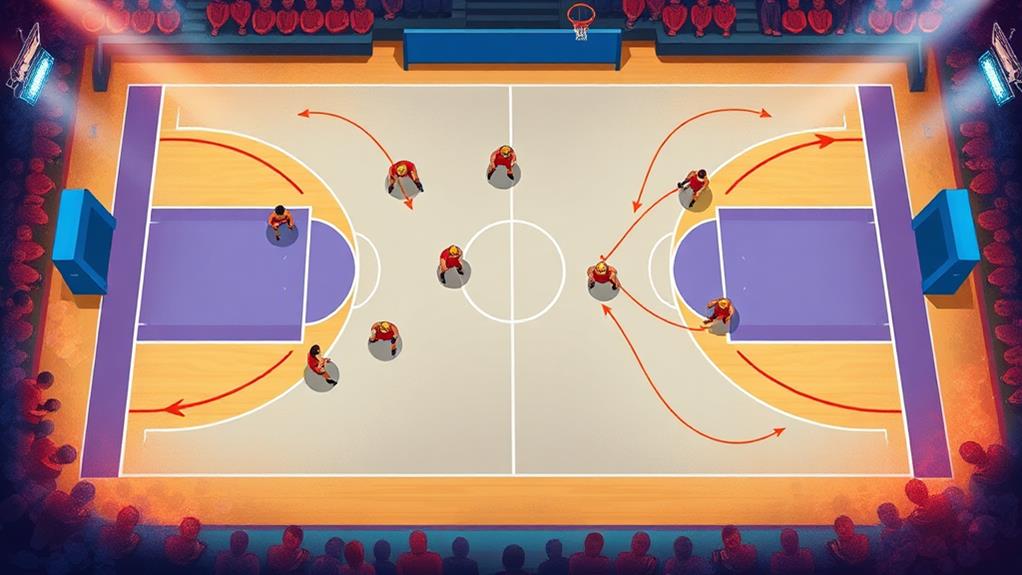
Executing the 1-2-2 zone defense relies on understanding key principles that guide your movements and decisions on the court. To effectively implement this defense, you need to focus on a few essential aspects that enhance your team's performance.
The evolution of defensive strategies has shown that adaptability is necessary, and the 1-2-2 zone can be particularly effective against modern offenses that prioritize perimeter shooting and quick ball movement, which reflects the historical shifts in defensive approaches.
- Ball Pressure: Apply consistent ball pressure with your hands up to disrupt the offensive flow and force quicker decisions from opponents.
- Movement on the Pass: Move in unison with the ball as it travels, ensuring you're ready to react and cover your assignments.
- Prevent Inside Passes: Prioritize denying entry passes into the paint, as these can create high-percentage scoring opportunities for the offense.
- Rebounding Commitment: Every player must locate their assignment and box out effectively to limit second-chance opportunities.
- Defensive Roles Clarity: Clearly define and communicate each player's responsibilities within the zone to maintain defensive integrity and coordination.
Adjustments and Player Movement
Adjusting to the offense's movements is essential for maintaining the strength of the 1-2-2 zone defense. As the ball is passed, you must dynamically shift your positioning. The closest defender should apply pressure, while the others maintain coverage in their designated areas.
When the ball swings, Player 5 needs to quickly recover to their original position to prevent gaps in the defense, minimizing scoring opportunities near the basket. Proper spacing on the court can help facilitate these adjustments, similar to how field dimensions dictate player positioning in soccer.
Effective communication among players is critical for smooth and timely defensive rotations. As offensive players move, recognize their intentions and adjust your responsibilities accordingly. Be on the lookout for potential backdoor cuts or open shooters, and switch assignments as necessary.
When double-teaming, it's essential that Player 5 doesn't overcommit to the low post. This balance is key to preventing easy inside passes to open players.
Quick recognition of offensive player movement and proactive adjustments will maintain the integrity and effectiveness of your zone defense. By staying alert and responsive, you'll create a defensive unit that's hard to break down, ultimately leading to better results on the court.
Mixing Defensive Strategies
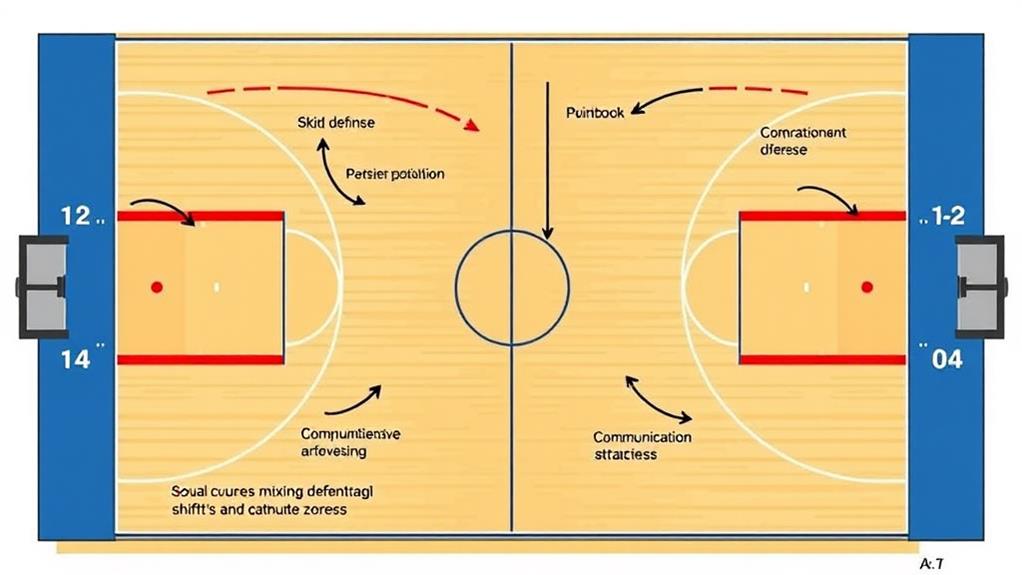
Mixing defensive strategies can be a game-changer, keeping opponents off balance and struggling to find their rhythm. By incorporating various defenses like man-to-man and 1-4, you create confusion that disrupts their flow.
Prioritize quality training sessions to guarantee your team understands these strategies thoroughly. Switching your defensive alignments every few possessions forces the offense to rethink their approach, making it harder for them to exploit weaknesses.
To effectively mix defensive strategies, consider these key points:
- Understand multiple concepts: Guarantee players grasp different defensive frameworks to shift seamlessly.
- Keep the offense guessing: Frequent changes in defense create uncertainty for opponents.
- Focus on defensive integrity: Prioritize maintaining strong defense over a limited offensive playbook.
- Capitalize on mismatches: Flexibility allows you to adapt your defense to target opponent weaknesses.
- Change game momentum: A well-timed switch can turn the tide of a match.
Situational Defensive Techniques
In various game situations, employing specific defensive techniques can make all the difference in maintaining your team's effectiveness on the court. One key aspect is defending skip passes. When an offensive player makes this move, the weak-side Wing Defender must quickly close out to challenge the shooter.
Don't forget to communicate with your teammates to guarantee your coverage of passing lanes remains tight. Regular practice enhances these skills, allowing defenders to react quickly and effectively during vital moments, as noted in Defensive Stance Drills for Beginners.
Additionally, consider situational trapping in the corners. By doing this, you can catch the offensive player off guard, limiting their options and creating turnover opportunities.
If you want to ramp up the pressure, extend your 1-2-2 Zone into a full-court or three-quarter court press. This tactic disrupts the opponent's flow, forcing hasty decisions.
When it comes to low post defense, remember that the weak-side Post Defender plays an essential role. Position yourself to help contest shots and intercept any passes that may come back out to the perimeter.
Learning Resources for Coaches
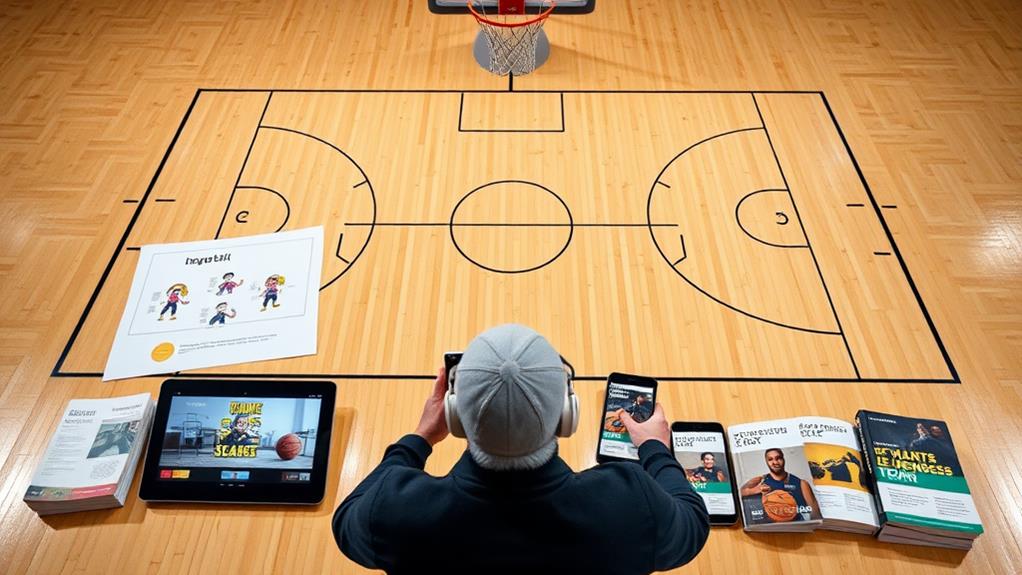
Numerous valuable resources are available for coaches looking to deepen their understanding of the 1-2-2 zone defense. By utilizing these tools, you can enhance your basketball training techniques and effectively implement set plays tailored to your team's strengths.
Understanding the evolution of basketball techniques, including innovations in defensive strategies, can provide insights into effective execution of the zone defense, as seen in the historical importance of teamwork and communication in basketball evolution of equipment and player gear.
- Coaching DVDs: Experts like Jay Wright and Joanne P. McCallie share in-depth strategies, drills, and game scenarios focused on the 1-2-2 zone defense.
- Books and Articles: Immerse yourself in literature that emphasizes defensive fundamentals, communication, and teamwork—crucial elements for executing the zone effectively.
- Online Platforms and Forums: Engage with fellow coaches discussing common mistakes and best practices related to the 1-2-2 zone, refining your approach in real-time.
- Coaching Clinics and Workshops: Attend these events for hands-on experience and valuable networking opportunities to share insights and strategies with other coaches.
- Rental and Purchase Resources: Many coaching resources are available to study various defensive techniques, allowing you to adapt them to meet your team's specific needs.
Importance of Defense in Games
A strong defense is essential for any basketball team aiming for success on the court. When you focus on your defensive strategy, you're not just limiting your opponent's scoring chances; you're also creating more opportunities for your own team.
Studies show that teams allowing fewer than 70 points per game have a notably higher win percentage, highlighting the correlation between strong defensive performance and winning.
A well-executed defense can lead to turnovers, which your team can convert into fast-break points, maximizing your scoring opportunities. By prioritizing defense in practice sessions, you improve team cohesion and communication, both imperative for executing an effective strategy during games.
Coaches emphasize that a strong defensive mindset disrupts the opponent's rhythm and builds confidence for your whole team. When everyone is on the same page, you foster momentum that can carry you through critical moments in the game.
Conclusion
Incorporating the 1-2-2 zone defense into your game plan is like adding a secret ingredient to a recipe—it can elevate your team's performance and keep opponents guessing. By understanding its strengths and weaknesses, assigning clear responsibilities, and practicing key principles, you'll create a formidable defensive unit. Don't shy away from mixing strategies to stay unpredictable. Remember, a solid defense can be the backbone of your success, turning the tide in tight games when it matters most.


